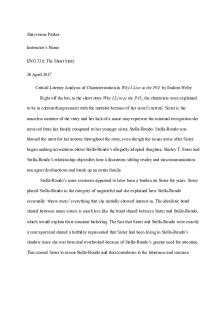Literary Analysis Questions for Beowulf PDF

| Title | Literary Analysis Questions for Beowulf |
|---|---|
| Course | world literature |
| Institution | Bataan Peninsula State University |
| Pages | 2 |
| File Size | 44.2 KB |
| File Type | |
| Total Downloads | 74 |
| Total Views | 143 |
Summary
analysis
sample
copy
text
literature
american literature
literature
english
beowulf
reading comprehension
american literature
beowulf
english
reading tetxt
...
Description
Literary Analysis Questions for Beowulf Directions: A. Be sure that all literary terms herein are defined in the “Literary Terms” section of your notebook. B. Answer each question completely. 1. The Prologue: The Beowulf poet begins his epic three generations prior to the time of the events of the main plot line. List the purposes of beginning in this way. (What does he indicate as important to the Anglo-Saxon culture? What effects might this prologue have on the overall story?)
2. Chapter 1: A. How might lines 67-70 be considered a biblical allusion? (What Bible story do they conjure? Why?) B. The Biblical references in lines 86-98 and lines 104-114 are not by definition allusions. What are the purposes of these references? How does their usage differ from the use of allusion?
3. Chapter 12: In line 791, the use of “That mighty protector of men” to name Beowulf is what is called an epithet, a word or phrase applied to a person or thing to describe an actual or attributed quality. A. How might that particular epithet be a contradiction to the Christian doctrine touted throughout the epic, as demonstrated in lines 809-811? B. List four epithets (including kennings) for Grendel used in this chapter.
4. Chapter 21: In Beowulf’s speech at the beginning of this chapter, identify and copy one statement that could be considered an aphorism. 5. Chapter 23: Alliteration, the repetition of consonant sounds at the beginning of words that are close together within the text, is a sound device used by poets throughout literary history. It creates aural (sound) imagery in which the reader hears the action as well as visualizing it. Discuss the specific effect of 3 examples of alliteration found in lines 1561-1569.
6. Chapter 34: Chapter 12 contains an understatement when Beowulf was battling Grendel, and the author states that Beowulf knew “the fiend was no use / To anyone in Denmark.” This understates the Dane’s need to be rid of Grendel. Another understatement is found in lines 2415-2416. Copy it. Explain its meaning and effect. Is this an example of litotes?
7. Chapter 36: Beowulf’s battle with the dragon is interrupted to introduce Wiglaf, tell the history of his sword, and allow him to reprimand the other Geats. A. Why is this interruption important to the overall epic? B. What does the Beowulf poet do in lines 2669-2693 to enliven the rest of the battle? (Quote specific lines and state their effect.)
8. Provide one example of foreshadowing from the epic. Quote and cite it, and explain what it makes the reader anticipate....
Similar Free PDFs

Literary Analysis Example
- 3 Pages

Literary Analysis (Genesis)
- 27 Pages

Literary Analysis Worksheet 1
- 2 Pages

Beowulf Study Questions
- 2 Pages

Literary Analysis The Gathering
- 3 Pages

Literary Analysis - Grade: A
- 2 Pages

Literary Analysis (I,Robot)
- 6 Pages

Literary Analysis- Eavan Boland
- 14 Pages

Literary Analysis Paper
- 3 Pages

Literary Analysis “The Bells”
- 1 Pages

Critical Literary Analysis
- 6 Pages

La Poesia - Literary Analysis
- 6 Pages

Literary analysis oliver twist
- 2 Pages
Popular Institutions
- Tinajero National High School - Annex
- Politeknik Caltex Riau
- Yokohama City University
- SGT University
- University of Al-Qadisiyah
- Divine Word College of Vigan
- Techniek College Rotterdam
- Universidade de Santiago
- Universiti Teknologi MARA Cawangan Johor Kampus Pasir Gudang
- Poltekkes Kemenkes Yogyakarta
- Baguio City National High School
- Colegio san marcos
- preparatoria uno
- Centro de Bachillerato Tecnológico Industrial y de Servicios No. 107
- Dalian Maritime University
- Quang Trung Secondary School
- Colegio Tecnológico en Informática
- Corporación Regional de Educación Superior
- Grupo CEDVA
- Dar Al Uloom University
- Centro de Estudios Preuniversitarios de la Universidad Nacional de Ingeniería
- 上智大学
- Aakash International School, Nuna Majara
- San Felipe Neri Catholic School
- Kang Chiao International School - New Taipei City
- Misamis Occidental National High School
- Institución Educativa Escuela Normal Juan Ladrilleros
- Kolehiyo ng Pantukan
- Batanes State College
- Instituto Continental
- Sekolah Menengah Kejuruan Kesehatan Kaltara (Tarakan)
- Colegio de La Inmaculada Concepcion - Cebu


